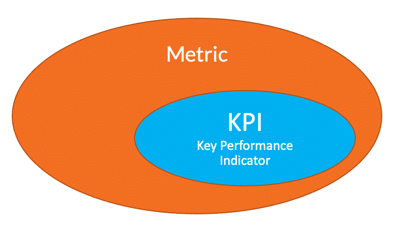Are you establishing the right objectives and measuring the right results?
Knowing the difference between BHAGs, OKRs, KPIs, and Metrics can make a major contribution to your business performance and eventual success.
So. Many. Acronyms.
It’s hard to keep them straight. Are you tracking an OKR… setting a KPI… or what?
It’s essential that your organization has a known, accepted, and concise common language when it comes to defining performance. Productivity begins with having a shared vocabulary where every member on the team understands what the other is saying and expecting.
Why does this matter? The truth is, it won’t matter if everyone in your organization can’t agree on the terms’ definitions—which results in them going unused.
Speed vs. Velocity
Terms like OKRs and KPIs are used in order to generate velocity. For example, without a clear understanding of these terms, your organization might cover a lot of distance this quarter (speed), but not be speeding in the right direction (velocity). These terms are used to clarify expectations in direction, destination, and speed.
There are a lot of approaches to setting objectives and monitoring results for your organization. Selecting an approach to setting goals that works and delivers results for your organization can make a major contribution to your performance and eventual success.
Each approach is like a toolbox that contains tools to fix or build an organization. Asking which approach is better is like asking which tool is better—a hammer or a screwdriver? It depends on the problem or the objective you’re trying to achieve. If you need to drive a nail, we suggest using a hammer. Need to turn a screw? Use the screwdriver.
The key is to select and communicate the best possible approach for your team. The approach should include tools from BHAGs, OKRs, KPIs, and Metrics. You can boost your chances of success by ensuring you’re taking the right approach to establishing targets and measuring progress towards them.
What is a BHAG?
A BHAG is a Big Hairy Audacious Goal that forces an organization to think big and create a plan for long-term success. It sets a huge goal that drives progress forward, defines a vision for the future, and gets everyone working toward achieving it. A BHAG is clear, compelling, and needs little explanation—people “get it” right away.
BHAGs can help a team re-imagine the industry they are in—to think in leaps versus incrementally. Aspirational goals are a terrific thing for a business to have, but it’s hard to overstate the importance of turning those goals into specific, concrete objectives.
Is True North a BHAG?
True North and BHAGs are similar, but not the same. True North is a direction, while a BHAG is a destination.
True North works as a compass to guide an organization from the current conditions to where they want to reach. It defines in which direction will the future be found. True North is a precise, concise, and universal set of ideals, which when followed, provides a defined direction to the organization.
A proper BHAG is clear and compelling and serves as a unifying focal point of effort—often creating immense team spirit. It has a clear finish line, so the organization can know when it has achieved the goal; people like to shoot for finish lines.
What is an OKR?
Once your team has a BHAG in mind, OKRs are the particulars on how you will achieve every step towards that reinvention.
OKR stands for Objectives and Key Results. OKRs are an effective goal setting and leadership tool for communicating what you want to accomplish (Objectives) and what milestones you’ll need to meet (Key Results) to accomplish it.
A good objective is significant, concrete, action-oriented, and inspirational. Good key results are specific, timebound, aggressive yet realistic, measurable, and verifiable. OKRs should represent what you most want to pursue or accomplish in a quarter.
For example, you might say, “I will (your objective) as measured by (these key results).”
If you don’t know where you’re going, how will you get there? A business that doesn’t have defined objectives is wandering, lost in the woods. The likelihood of success is remote since people in the business are not certain as to where they should be going.
Objectives form the structure for project development and measurement of performance along the way. Applying objectives to a project defines the timeline of activities needed to complete the plan.
There are a couple of big differences between BHAGs and OKRs. First and foremost is that a BHAG is a long-term goal that changes the very essence of a team’s existence. A BHAG will outlive a typical OKR cycle because BHAGs are usually crafted for commitments 10 to 30 years out.
An OKR cycle, on the other hand, is generally quarterly based within an annual plan.
Another major difference is that OKRs don’t always have to be so groundbreaking: they are a means to accomplish your goals and intentions with time-bound and measurable milestones. With OKRs, you can walk on the moon, set sales goals, and train for a marathon.
What is a KPI?
A Key Performance Indicator (KPI) is a measurable value that demonstrates how effectively a company is achieving key business objectives (OKRs). Organizations use KPIs to evaluate success at reaching targets. High-level KPIs may focus on the overall performance of the business, while low-level KPIs may focus on processes across departments like sales, marketing, HR, or customer support.
A KPI is only as valuable as the action it inspires. Often, companies try to adopt Key Performance Indicators used by other companies and use them as their own, then wonder why their goals are never met. Just as every employee is different, every organization is different. KPIs should be tailored to your specific organizational objectives, how you plan on achieving them, and who can act on this information. The purpose of KPIs is to analyze past performance and make predictions for the future.
KPIs are metrics while OKRs are a systemic goal-setting method. KPIs are used within the OKR framework to set growth goals and achieve more with alignment and execution. KPIs help every area of the business move forward at the strategic level. When used properly the two complement each other.
Use OKRs to lead. OKRs show both what you want to accomplish and how you’re going to get there. Change-oriented goals (Objectives) are paired with measures (Key Results). On the other hand, KPIs are standalone numbers (metrics). They don’t convey purpose, path, or progress.
What are metrics?
All KPIs are metrics, however not all metrics are KPIs. KPIs are the key metrics. Metrics are your “business as usual” measures that still add value to your organization but aren’t the critical measure you need to achieve.

Metrics and KPIs are often confused, but the clear difference is KPIs are the key measures that will have the most impact in moving your organization forward. They clearly articulate and provide insight into what your organization needs to measure and achieve to reach your long-term objectives. Metrics alone are not the most important metrics your organization needs to measure, monitor, and perform against to make progress against your strategic plan.
KPIs help define your strategy and clear focus. Metrics are your “business as usual” measures that still add value to your organization but aren’t the critical measure you need to achieve.
If you don’t set the right objectives and measure the right things, how will you know if you’re doing the right thing? Once you know your objectives, you get the most accurate picture of your progress when you’re measuring the correct goals with the appropriate units.
BHAGs, OKRs, KPIs, and Metrics are all toolboxes full of specific tools to help your organization succeed.



